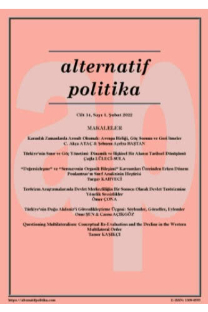GERMAN AND FRENCH “SPATIAL MANAGEMENT” OF REFUGEES ILLUSTRATED BY SYRIANS’ URBAN EXPERIENCES IN BERLIN AND MARSEILLES
Whereas the recent Refugee Studies with geographical approach often focus on the state-refugees nexus and living conditions in refugee camps or accommodation centres, we propose an analysis of the refugees’ residential insecurity and institutional constraints, questioning how they generate and influence individual strategies of urban integration and resettlement. Hence, our approach is to compare the politically established, multi-scaled “spatial management” of refugees with the refugees’ individual actions and decisions within their spaces of arrival. For this, we compare Marseilles’ and Berlin’s accommodation systems and urban specificities that come within two different national and local settings in terms of politics and migration patterns. The core question we address is to understand if and how these two barely comparable political and administrative systems can still lead to similar refugee resettlement patterns within urban spaces. The studies are based on the authors’ intensive ethnographic fieldwork in both cities that helped carry out in-depth case studies on Syrian nationals.
___
Agier, Michel (2008), Gérer les indésirables: des camps de réfugiés au gouvernement humanitaire, (Paris: Flammarion).Agier, Michel (2012), “Du superflu au sujet. Biopouvoir et politique en situation d’exception”, Le sujet dans la cite, 1 (1): 5-9.
BAMF (2017), www.bamf.de/DE/Infothek/Statistiken/statistiken-node.html (10.10.2017).
Barwick, Christine (2011), “Draußen vor der Tür – Exklusion auf dem Berliner Wohnungsmarkt”, WZB-Mitteilungen, 134: 13-15.
Baby-Collin, Virginie and Assaf Dahdah (2017), “Miroir de la précarité sociale et (carrefour) des dynamiques migratoires. Les hôtels dits meublés du centre-ville marseillais”, Faire-Savoirs, 13: 65-74.
Bonis, Margot (2016), Rapport d’activité 2015, (Marseille: Plateforme Asile HPF).
Bruslé, Tristan (2015), “Habiter un camp de travailleurs. Appropriation, usages et valeurs du dortoir en milieu contraint”, Annales de géographie, 702-703 (2): 248-274.
Cimade (2017), “Etat des lieux du dispositif d’accueil des demandeurs d’asile”, www.lacimade.org/schemas-regionaux-daccueil-des-demandeurs-dasile-queletat-des-lieux (25.10.2017).
Crisp, Jeff, Tim Morris and Hilde Refstie, (2012), “Displacement in urban areas: new challenges, new partnerships”, Disasters, 36 (1): 23-42.
Crisp, Jeff (1999), “Who has counted the refugees? UNHCR and the politics of numbers”, UNHCR Centre for Documentation and Research, Working Paper, 12: 17.
Dahdah, Assaf, Gwenaelle Audren and Florence Bouillon (2017), “La ville (in)hospitalière: parcours scolaire et résidentiel d’une famille syrienne à Marseille”, Espaces et Sociétés, 172-173: 9-14.
Darling, Jonathan (2016), “Forced migration and the city: Irregularity, informality, and the politics of presence”, Progress in Human Geography, 41 (2): 1-21.
Dippel, Annika (2017), “L’habiter des réfugiés berlinois et leurs modalités d’accès à la ville et à la société d’accueil”/ “Refugees’ strategies to access city and society in Berlin”, Master’s thesis, Aix-Marseille University (Aix-enProvence).
Gastaut, Yvan (2002), “Le cosmopolitisme, un univers de situations”, Cahiers de l’Urmis, 8: 4.
Han-Broich, Misun (2012), Ehrenamt und Integration. Die Bedeutung des sozialen Engagements in der (Flüchtlins-)Sozialarbeit, (Wiesbaden: Springer Fachmedien).
Hinz, Thomas and Katrin Auspurg (2017), “Diskriminierung auf dem Wohnungsmarkt”, Scherr, Albert, Aladin El-Mafaalani and Gökçen Yürksel, Handbuch Diskriminierung, (Wiesbaden: Springer Fachmedien): 387-406.
Jaber, Hana (2016), “Réfugiés syriens en Jordanie: choc démographique, résiliences et vulnérabilités”, Confluences Méditerranée, 99 (4): 95-108.
Kobelinsky, Carolina (2008), “‘Faire sortir les déboutés’. Gestion, contrôle et expulsion dans les centres pour demandeurs d’asile en France”, Cultures & Conflits, 71: 113-130.
Lassailly-Jacob, Véronique (2006), “Territoires d’exil, les camps de réfugiés”, Bulletin de l’Association des Géographes Français (BAGF), 83 (1).
Ma Mung, Emmanuel (2009), “Le point de vue de l’autonomie dans l’étude des migrations internationales: penser de l’intérieur les phénomènes de mobilité”, Dureau, Françoise and Marie-Antoinette Hily, Les mondes de la mobilité, (Rennes: Presses universitaires de Rennes): 25-38.
Mazuy, Magali, Magali Barbieri, Didier Breton and Hippolyte d’Albis (2015), “L’évolution démographique récente de la France et ses tendances depuis 70 ans”, Population, 70 (3): 417-486.
OFII (2015), Les chiffres de l’OFII, 2014, (Paris).
OFPRA (2017), Rapport d’activité, 2016, (Fontenay-sous-Bois).
Phillimore, Jenny and Lisa Goodson (2006), “Problem or Opportunity? Asylum Seekers, Refugees, Employment and Social Exclusion in Deprived Urban Areas”, Urban Studies, 43 (10): 1715-1736.
Robinson, Vaughan, Roger Andersson and Sako Musterd (2003), Spreading the ‘Burden’? A Review of Policies to Disperse Asylum Seekers and Refugees, (Bristol: The Policy Press).
Temime, Emile, Pierre Echinard and Abdelmalek Sayad (2007), Migrance, histoire des migrations à Marseille, (Marseille: Jeanne Laffitte).
UNHCR (2009), UNHCR policy on refugee protection and solutions in urban areas (Geneva).
Yurdakul, Gökce, Regina Römhild, Anja Schwanhäusser and Birgit Zur Nieden (2017), Witnessing the transition: Moments in the Long Sommer of Migration, (Berlin: Berlin Institute for empirical Integration and Migration Research).
- ISSN: 1309-0593
- Yayın Aralığı: Yılda 3 Sayı
- Başlangıç: 2009
- Yayıncı: Rasim Özgür Dönmez
Sayıdaki Diğer Makaleler
“CITIES: IDENTITIES, APPROPRIATION OF SPACE AND RESISTANCE PRACTICES”
WOMEN AND RESISTANCE IN URBAN SPACE
THE EMERGENCE OF RIO DE JANEIRO’S MUSLIM COMMUNITY IN THE CITY’S PUBLIC SPACE
NEOLİBERAL YENİDEN ÖLÇEKLENME ETKİSİ ALTINDA TÜRKİYE’DE KENTLEŞME POLİTİKASININ DÖNÜŞÜMÜ
THE REAL FUNCTION OF THE “DISASTER LAW” IN THE URBAN DEVELOPMENT OF ISTANBUL
